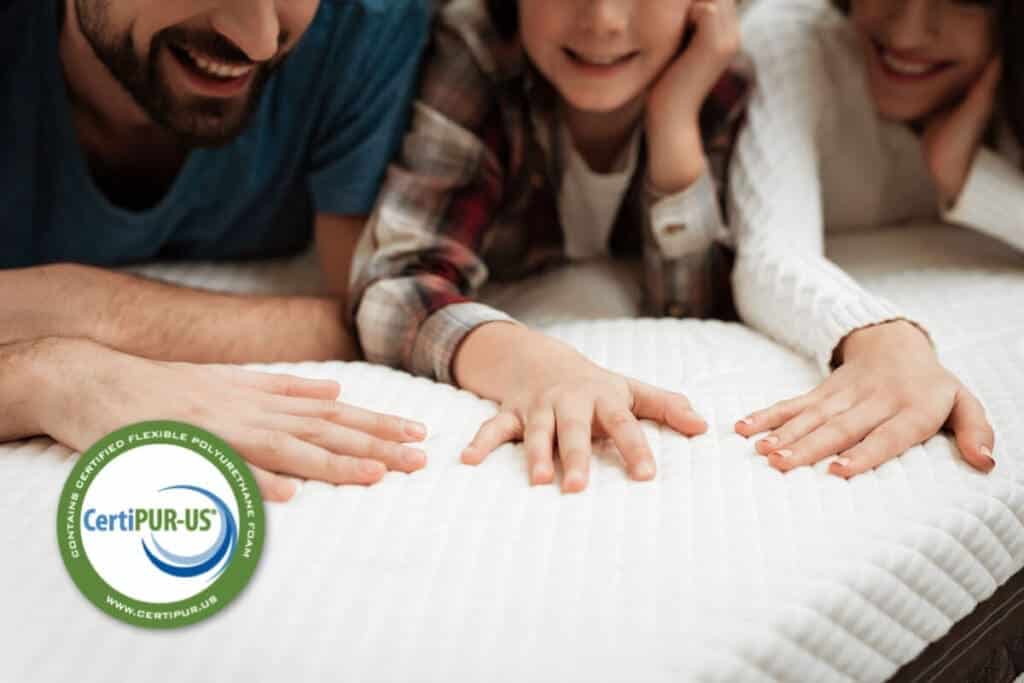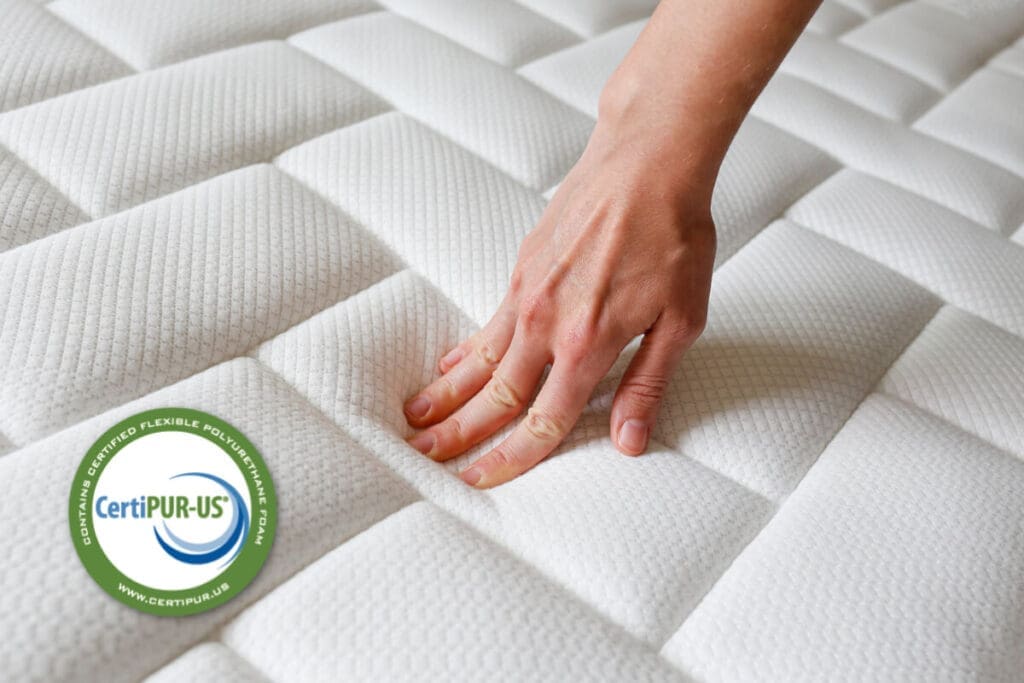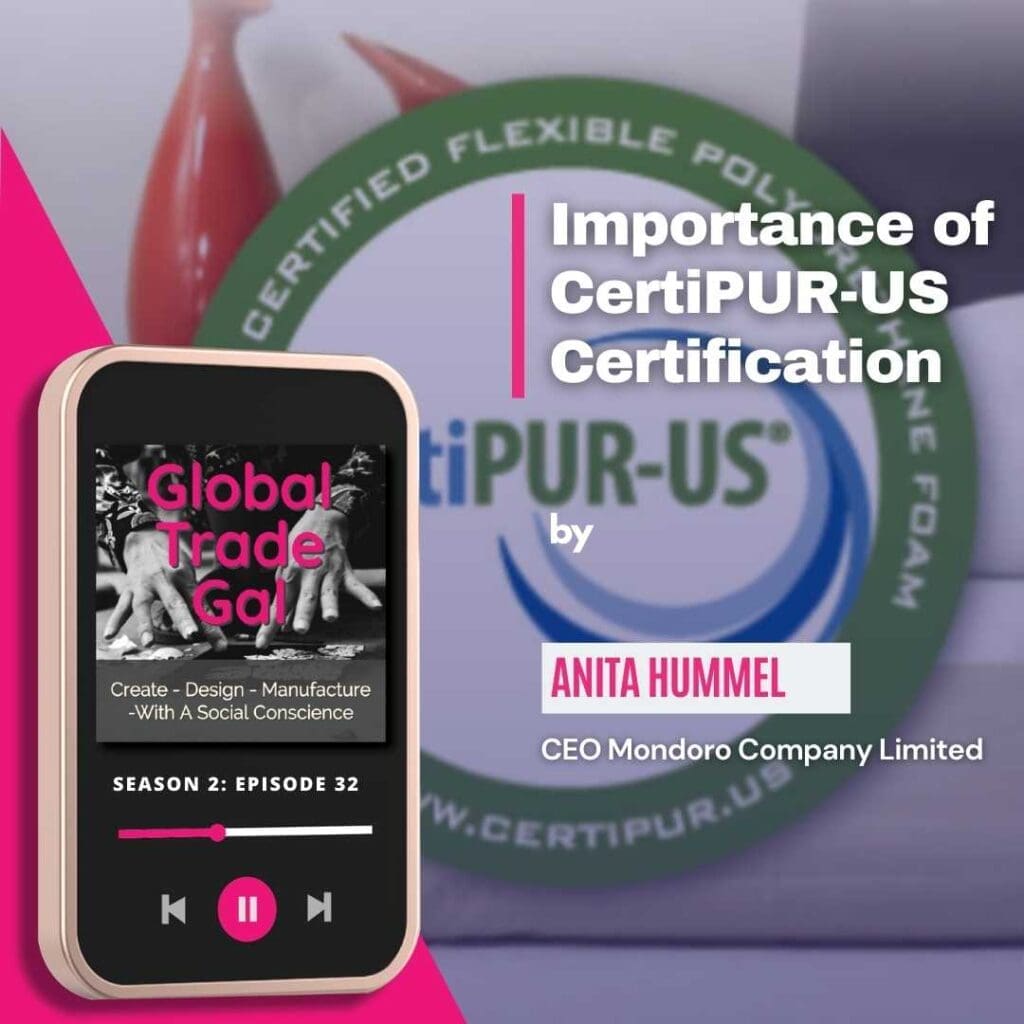When you purchase a mattress or another foam product, you may see a CertiPUR-US certification on the product.
CertiPUR foam is certified to be made without harmful toxins or causing damage to the environment. The foams also do not have fiberglass in them. CertiPUR will test all the foams to ensure that it meet or exceeds its standards.
Table of Contents
- What Is The CertiPUR-US Certification?
- CertiPUR-US Use No Fiberglass
- CertiPUR-US Foam Eliminates Toxins
- CertiPUR-US Ensures Foam Is Produced Without Ozone Depleters
- CertiPUR-US Ensures Foam Made Without Harmful Substances
- CertiPUR- US Foam Is Made Without Harmful Fire Retardants
- CertiPUR- US Foam Is Made Without Formaldehyde
- CertiPUR- US Foam Is Made Without Phthalates
- CertiPUR- US Mattress Foam Is Made With Low VOC Emissions
- Related Content
What Is The CertiPUR-US Certification?
The CertiPUR label is a relatively new certification process specifically for foam manufacturers. The CertiPUR-US is a Not-for-Product company and runs similar to other home decor certifications such as UL or Underwriters Laboratories for lamps, lighting, and other products.

The purpose of CertiPUR-US certification is that manufacturers can show that they can meet specific product standards and safety requirements. For CertiPUR-US certifications, it comes down to about three primary areas:
- Environment – In the past, many foam manufacturers worldwide used substances that were harmful to the environment to manufacture their foam. They would use harmful chemicals that actively deleted the world’s ozone layers and contributed to environmental issues worldwide. CertiPUR-US Certification ensures that manufacturing foam products protects the environment.
- Harmful Chemicals – Many foam manufacturers used some very harmful chemicals in the past. Some of these chemicals were linked to diseases such as cancer or congenital disabilities. Others could cause harmful chemicals to get into the air, including indoor air in someone’s home. CertiPUR-US certification is about eliminating those harmful chemicals in foam manufacturing to ensure no harmful chemicals are used.
- Transparency – One of the core principles of CertiPUR-US is transparency. The aim is to ensure the manufacturers are transparent in their manufacturing progress of the foam.
CertiPUR-US has an aggressive program to monitor its label and its use. From the CertiPUR-US website they have said:
“We have an aggressive program in place to monitor the use of the CertiPUR-US logo/name and to conduct random samples of certified products for verification purposes. The integrity of the program and its value to participating companies is enhanced through vigilant protection. We emphasize transparency so that we continue to earn consumers’ confidence.”
CertiPUR-US

CertiPUR-US Use No Fiberglass
One of the main aspects of CertiPUR-US foam is that the foam should not have any harmful substances or fiberglass material. Some foam uses fiberglass as a cheaper alternative to other materials.
The CertiPUR-US foam should not use fiberglass for a mattress, pillow, or upholstered furniture. But there are some exceptions to this. This is what CertiPUR-US says on their website about some exceptions to the fiberglass:
“However, some mattress manufacturers surround a mattress’s foam core with barrier fabrics made from fiberglass to help meet government standards for mattress flammability. A mattress zipper is usually there for easy assembly at the factory and not for the customer to use. For that reason, never remove the cover of your mattress, even if it has a zipper, unless the mattress cover is specifically intended to be removed for laundering.”
Certipur-US
So, in theory, the CertiPUR-US foam does not have any fiberglass. However, there could be fiberglass in other materials surrounding the mattress, pillow, or other products that still have fiberglass.
That is why CertiPUR-US recommends you do not remove the mattress cover or other cover of your product but instead use a mattress pad or some other way to protect your product.
CertiPUR-US Foam Eliminates Toxins
At the core of CertiPUR-US is that they want to eliminate toxins in the foam products that are used. This includes toxins in the air and also in the foam.
Here are some significant toxins they eliminate in their products and why this is important.
CertiPUR-US Ensures Foam Is Produced Without Ozone Depleters
Ozone-depleting substances are materials that are known to hurt the earth’s ozone layer. The EPA, or the Environmental Protection Agency, has a list of substances known to hurt the earth’s ozone layer.
The main reason was that foam manufacturers used chlorofluorocarbons (CFCs). CertiPUR- US ensures that the foam manufacturers with the CertiPUR- US certification do not use any ozone-depleting substances or chlorofluorocarbons to manufacture the foam.

Listen To Our Podcast, Importance of CertiPUR-US Certification, below or by clicking here.
CertiPUR-US Ensures Foam Made Without Harmful Substances
The CertiPUR-US Certification also ensures that form suppliers with the CertiPUR-US label do not use any other harmful substances in their foam manufacturing. The significant chemicals would be mercury, lead, and other heavy metals. Though they are not that common in foam manufacturing, they can ot be used in manufacturing foam under the Certi-PUR-US certification.
CertiPUR- US Foam Is Made Without Harmful Fire Retardants
CertiPUR-US does not allow manufacturers to use flame retardant materials that could damage a person’s health or substances the Environmental Protection Agency (EPA) banned.
Here is a list of some of the chemicals that are not allowed to be used under the CertiPUR-US certification:
- Polybrominated Diphenyl Ethers, Or PBDEs – Is a substance that some manufacturers use to meet certain states’ flammability requirements. But these PBDEs were also banned by the US Environmental Protection Agency in 2005 and cannot be used in CertiPUR-certified foam.
- Tris Or TCEP And TDCPP – These substances are known to be linked to cancer and may cause congenital disabilities or damage to fertility or an unborn child. They are also banned in all CertiPUR- US-certified foam.
CertiPUR- US Foam Is Made Without Formaldehyde
Even though formaldehyde has never been used in foam, some foam can cause formaldehyde to enter the surrounding air. Formaldehyde is a harmful substance that is not allowed in CertiPUR-US-certified foam.
CertiPUR-US will do a test to ensure the CertiPUR-US-certified foam has no formaldehyde present.
CertiPUR- US Foam Is Made Without Phthalates
Phthalates are mainly used in foam as a softening agent. The Consumer Product Safety Improvement Act (2009) eliminated the use of this substance for children’s toys and items.
CertiPUR-US requires that foam manufacturers show that they do not use this in their foams.
CertiPUR- US Mattress Foam Is Made With Low VOC Emissions
Volatile Organic Compounds (VOC) are a significant component of air pollution problems. VOC in household products can hurt or damage indoor air quality.
CertiPUR-US tests all certified foams in a small chamber to ensure that CertiPUR-US foams have low emissions for any VOCs. This will ensure that any CertiPUR-US certified foam will not add to any VOCs.
It is all these harmful substances CertiPUR strives to eliminate in their foam. They believe that foam should be produced with harmful substances that differentiate a CertiPUR-certified mattress, pillow, or foam from other products.
You can find out more about the CertiPUR-US program by clicking here.
If you are interested in seeing how Mondoro can help you with your foam, mattresses or other home decor products – we would love to talk to you about how we can help you.
Find out more about how Mondoro can help you create, develop, and manufacture excellent home decor and furniture products – don’t hesitate to contact me, Anita. Check out my email by clicking here or become a part of our community and join our newsletter by clicking here.
Mondoro gives out a FREE Lookbook to anyone interested. You can receive a copy of our latest Lookbook by clicking here.
Listen to our Podcast called Global Trade Gal. You can find it on all major podcast platforms. Try out to listen to one of our podcasts by clicking here.
Subscribe to our Mondoro Company Limited YouTube Channel filled with great videos and information by clicking here.
Related Content
The Tre Natural Color Trend for Home Decor and Home Furniture
Tre means bamboo. But it also helps to symbolize the strength and ability to be resilient. The Tre trend is about having nature as part of your life and home. The Tre natural color palette has a lot of lush green tones. The Tre trend can be used together with other home decor and furniture trends.
You can discover more by reading The Tre Natural Color Trend for Home Decor and Home Furniture by clicking here.
Can Cane Furniture Be Left Outside?
Cane furniture is not outdoor weather-resistant; manufacturers produce outdoor weather-resistant furniture from synthetic, not natural, cane materials. Throughout history, cane furniture was in outdoor settings in many parts of the world; during that time, there was no genuinely outdoor weather-resistant furniture.
You can learn more by reading Can Cane Furniture Be Left Outside? by clicking here.
What Is The Difference Between Rattan, Wicker, And Cane Furniture?
Rattan is a type of palm or vine that grows in the jungles of Southeast Asia. Rattan refers to a kind of natural material. Wicker is a type of weave using rattan materials. Cane also refers to a type of weave that is usually woven using rattan material.
You can learn more by reading our blog, What Is The Difference Between Rattan, Wicker, And Cane Furniture? by clicking here.

